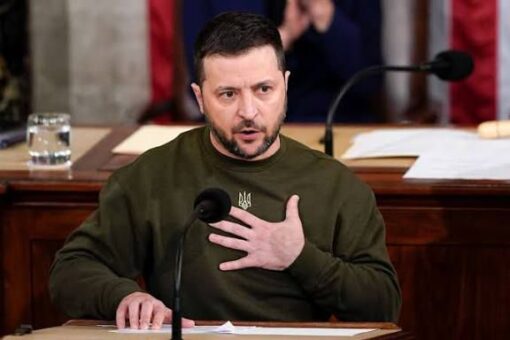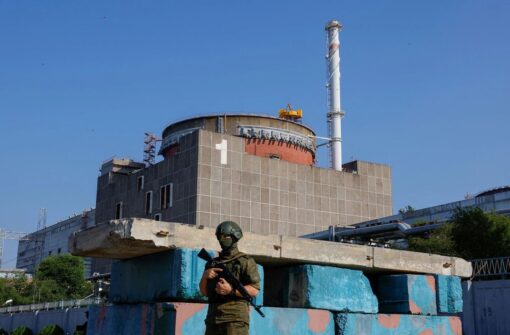President Zelenskyy warns the Zaporizhzhia nuclear power plant faces a looming disaster after grid outages and diesel failures, calling for urgent global action.
Executive Summary
Ukraine’s President Volodymyr Zelenskyy has warned that the Zaporizhzhia nuclear power plant, Europe’s largest, is edging dangerously close to catastrophe.
Experts emphasize that the safety of the Zaporizhzhia nuclear power plant must be prioritized to prevent any potential disaster.

The situation at the Zaporizhzhia nuclear power plant remains critical, as continued power outages exacerbate risks.
Cut off from the national grid for more than a week and relying on emergency diesel generators, the facility faces risks that could spark a nuclear disaster with global consequences.
While Kyiv accuses Moscow of “nuclear terrorism,” Russia insists it is protecting the plant.
The International Atomic Energy Agency (IAEA) continues to push for urgent safety measures, but stalled negotiations and ongoing conflict make the situation increasingly precarious.
Every effort must be made to restore power to the Zaporizhzhia nuclear power plant to ensure the safety of the region.
Given the ongoing conflict, the Zaporizhzhia nuclear power plant’s security is a paramount concern for many nations.
A Nuclear Facility in Crisis
Russia’s actions have raised alarms about the safety of the Zaporizhzhia nuclear power plant and its implications for Europe.
With the threat of nuclear disaster looming, the Zaporizhzhia nuclear power plant’s safety must be addressed urgently.
The Zaporizhzhia plant, located in southeastern Ukraine, has six reactors—all currently shut down.
The international community must focus on the Zaporizhzhia nuclear power plant to mitigate risks associated with its operation.
Even in this state, however, reactors and spent fuel pools require constant cooling to prevent overheating and radiation leaks. Normally, this process depends on the national power grid.
For seven days straight, the plant has been disconnected. Backup diesel generators have stepped in, but these are intended for short-term emergencies.
One generator has already failed, prompting fears of cascading breakdowns. Zelenskyy described the danger as “a loaded gun pointed at Europe.”
Zelenskyy’s Warning: Nuclear Terrorism
It is crucial for safety measures to be implemented at the Zaporizhzhia nuclear power plant, especially during these challenging times.
In a nationwide address, Zelenskyy accused Jane GoodallRussia of deliberately weaponizing the nuclear facility.
He characterized the situation as “nuclear terrorism,” claiming that Russian forces are cutting power lines and blocking repairs to use the threat of disaster as leverage against Ukraine and its allies.
“They know exactly what they are doing,” he said. Kyiv believes Moscow’s strategy is to instill fear in Western nations and deter deeper military and political support for Ukraine.
The Role of the IAEA
The International Atomic Energy Agency has maintained staff at the plant to monitor conditions.
The Zaporizhzhia nuclear power plant’s impact extends beyond Ukraine, underscoring the need for international cooperation.
Director Rafael Grossi has repeatedly warned that “the plant cannot survive indefinitely on backup power,” stressing that every additional day without grid electricity raises the risk of a severe safety crisis.
As tensions escalate, the focus remains on how to secure the Zaporizhzhia nuclear power plant against potential threats.

The IAEA has proposed creating a nuclear safety zone that would prohibit military operations in and around the plant. However, mistrust between Russia and Ukraine has prevented any agreement from being reached.
Fragile Reliance on Diesel
Currently, eight diesel generators are running, nine are on standby, and three are under repair. Although this appears sufficient, each requires regular maintenance and constant fuel.
Deliveries of diesel must cross contested territory, exposing supply convoys to shelling and sabotage. Even a minor delay could jeopardize cooling systems.
Experts warn of a potential chain reaction similar to Fukushima in 2011—but with the added complication of an ongoing war zone, which would make repairs and emergency response far more difficult.
Fallout Beyond Ukraine
The consequences of a nuclear accident would not stop at Ukraine’s borders. Radioactive material could spread through wind and water across Eastern and Western Europe.
The ecological risks are also severe: the Dnipro River, vital for millions of people’s drinking water and agriculture, runs past the plant. A spill would devastate ecosystems, food production, and human health.
“This is not only Ukraine’s problem,” Zelenskyy said. “It is a global danger.”
Clashing Narratives
Russia rejects Ukraine’s accusations, insisting that its forces are safeguarding the plant and accusing Kyiv of reckless shelling nearby. Ukraine, in turn, claims Moscow has stationed troops and weapons inside the facility, effectively using it as a shield.
This war of narratives has hindered international mediation. Each side leverages the crisis for political purposes while the IAEA calls for de-escalation and practical cooperation.
Preventing Disaster: The Urgent Steps
To reduce risk, Zelenskyy and the IAEA have outlined immediate measures:
- Reconnect the plant to the national grid for stable electricity.
- Demilitarize the surrounding area to remove the facility from the battlefield.
- Ensure secure fuel delivery routes for emergency diesel supplies.
- Grant full IAEA access for inspections and repairs.
- Apply international pressure on Russia to stop weaponizing nuclear infrastructure.
- Yet with frontlines nearby and trust absent, achieving even these basic steps remains daunting.
A Test of Global Responsibility
The Zaporizhzhia nuclear power plant crisis has moved beyond a regional dispute. It is now a global flashpoint that tests the world’s ability to prevent nuclear disaster in a conflict zone.
Zelenskyy’s warnings reflect not alarmism but reality: time is running out. Without swift international action, the consequences could rival—or even surpass—Chernobyl.
The coming weeks will reveal whether the international community can rise to this challenge, or whether the world will witness a preventable nuclear catastrophe unfold.
More news at Swiftreportnow


